Based on the popularity of Live Design's 31 Days Of Plots in December each year, we have decided to present Plot Of The Week, with a light plot (or plots) per week until December 2023, when the next 31 Days Of Plots begins.
TERHAL, from international culture and experience design company Dragone, ran from March 2-19 in Diriyah, Saudi Arabia. Created in conjunction with the Saudi Ministry of Culture, the production includes a cast of over 60 Saudi artists and 60 international artists who lead the audience on a journey through the Kingdom's history. Sadly, TERHAL was the first production to open since the death of Dragone's founder and artistic director, Franco Dragone.
Lighting designer Josh Selander shared his process and inspiration for the production with Live Design.
Live Design: What were some of the challenges at the venue for this show?
Josh Selander: We were designing the room, the rig and the truss until the moment the show opened. Literally, this room was constructed for this show, we started loading the show in before the walls to the venue were actually installed. We used A Loud Minority based out of Dubai, which acted as the technical direction group for the show. Specifically Karl Jenkins, director of A Loud Minority, was integral to getting this show organized and installed in the short timeframe that we had.
The primary challenge for all teams was the schedule—this was very tight for all of us. At opening night, we realized that less than four weeks prior there were significant portions of the building that had not been finished yet. The actual creation process in the room was the shortest amount of time that I have ever seen put into a show of this scale, a true testament to the caliber of professionals that Dragone put on this project to collaborate and create.
We were able to mount part of the show in Dubai, where the show utilized a film stage to begin initial creation. I was fortunate to have part of the lighting rig also installed to begin layering lighting in to the show. Since time was going to be such a concern, without this added time in Dubai, I don’t see how we would have been able to finish lighting the show. We switched to running previz for two weeks between Dubai and Saudi Arabia as they needed to load our lighting rig in. This also was extremely important for us to be able to layer the remaining fixtures into the show, while not perfect, it was certainly crucial to get this first layer down.
Most of the show happened in the last two weeks of creation, maybe even in the last week. The timeline of equipment, costumes, content and even the venue made it very tight to see all of the elements together without having much time to change. The lighting rig was designed in October, without much changing in it through the evolution of the process. The quantity of fixtures was locked and we really needed to stay on budget with the lighting equipment. The changes that we were able to make were based more on distribution of equipment and adjusting to how the scenic or venue elements changed.
This arena show incorporated a large amount of acrobatics and dance, with a rather large audience seating area. I knew it would be difficult to fit side lighting in to the rig, knowing that this was also going to potentially blind parts of the audience since we played 270 degrees. I also had intended that we would hide as much of the rig as possible, so I wanted to trim out everything at its maximum height to conceal it. Add the extremely high angle to the lightly colored floor and it made lighting the humans without obscuring the video content really difficult. Luckily, the relationship that I have with the team from Drop the Spoon paid off, and we were able to rely on each other to find ways around this.
The chandelier was the biggest unknown for me—a three tiered circular roll drop that lived in the center of the room, that also needed to be projection mapped. We had 95% of the show designed before we had the chandelier incorporated into the system, due to availability of product, this added some significant and quick design choices to be altered. I learned early on working with this team, you need to trust the process and I really encouraged the directors that we should test and try new ideas. As painful as it was to make the changes, I believe that we absolutely needed to do this to bring every element together.
Scale. Scale. Scale. This is a massive amount of space to light. Our main stage is just over 36 meters wide and from DS to our farthest US point is 55 meters. When you look at this plot on a piece of paper or a computer, it becomes difficult to comprehend the scale of this when you aren’t used to playing a room this large.
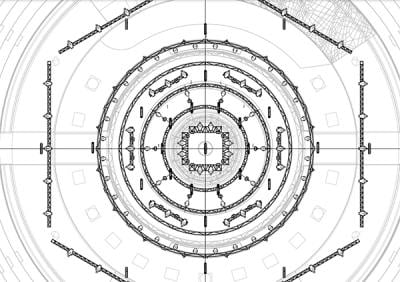
(Find more lighting plots below)
LD: Can you talk a little bit about your choice of gear, control and fixtures?
JS: I started working on the gear list before we even knew what the options were. At some point, I knew I needed a spot, beam and wash, plus some additional house lights and strobe effects. Add on to this that we knew there would be a lot of sand and some water near some of the fixtures, we added the requirement of an IP-rated fixture. Once we were able to identify a rental shop, we worked with the gear that we knew that we would have access to. The size of the room greatly determined the type of fixtures, and the quantity of these fixtures available by BeWunder narrowed down our search. We needed an ultra bright white source moving profile with shutters, and the Mac Ultra Performance fit the requirements perfectly.
When I first began meeting with Tiziana and Filippo, their original concept incorporated many beams throughout the room. We knew we needed a light that could both compete with the brightness of the Ultras, but could also hold their own as a functional profile. The Megapointe was a fabulous hybrid fixture that filled a void in the rig and the room due to the obstructions that existed. We were able to see those beautiful beams in the air, have a quick snap into a wide template and fit the light in the small areas that lived between some of the scenic elements in the room.
No rig would be complete without a wash light, I went with what BeWunder had available, Robe Spiiders. Tim and I decided that due to the timeline of the show, we wouldn’t have the time to get into individual pixel control, but still gave us options in regards to limited mapping and control of the flower effect.
We went with two different strobes in show, I’ve always been a huge fan of the Martin Atomic 3k LED and this really helped deliver some beautiful floor effects in the room. The punch of the strobe with the added aura colors gave great depth into the scenes we used them in. It is such a simple but beautiful and practical fixture. We also used the JDC-1 fixture from GLP, this was solely for air effects and audience blinders that I could tilt around the room.
I decided early on that I wanted to have a flexible cyc lighting solution—Something that I could not only use to light the cyc (we actually had a drop custom printed for the show) but also swing it out onto the stage. To fulfill this I went with the X4-Bar 20 also from GLP on both top and bottom. We also added additional lights and textures from side positions to augment the fixtures and fill in.
On the floor we used a rig of Ayrton Perseo fixtures and Robe BMFL Blades. Both fixtures were a true surprise in how much they were relied on, creating beautiful shadows and textures on both the cast and the chandelier that Patrick had as the central scenic element.
Other gear in the room included a large inventory of LED pars to support house/lobby lights, a full haze system supported by MDG ATMe’s and a few hundred meters of led tape built into the floor. Set electrics included Astera tubes of various sizes integrated into the chandelier and souq carts.
Control in the system was provided by an ETC Eos Ti primary and backup, this was an obvious choice for me, but was certainly a smooth implementation and I've never had a problem with a system this size.
We also used a Follow-Me system in the production—there were a total of four operators who controlled multiple targets that utilized all of the Ultras and Spiiders in the rig. This allowed us to have what seemed like an infinite amount of followspot angles, which became more important as more scenic elements were being added into the show.
Full system integration was made possible by BeWunder, who we worked closely with from our the first day we arrived in Dubai. Their team was instrumental in putting the show together both in Dubai and Riyadh. We had an absolute fail-proof system designed and installed, with the absolute best technicians that we could have asked for.
LD: Do you have a favorite workhorse piece of tech that you rely on?
I am a control nerd—I worked for ETC for many years before being a programmer and then transitioning to designing shows. As a programmer/designer on multiple projects I always lean into the power and simplicity of Eos. This show was no exception for me, knowing that I would have ETC’s full support if needed behind me. I also knew that if Hunter (the programmer) had any issues, I could back him up with help or guidance along the way. This was a fast-paced show to create, and while we typically stayed in a linear order, the natural process of creation has us jump around a lot in cueing.
The underdog for me in this case, that will now be a show requirement, is actually a piece of auxiliary software we ran with Eos called Vor. This program allowed us to not only record videos of the show, but it also allowed us to take a program and timecode input from the sound team of each rehearsal and show. This was instrumental in the note taking process, especially since both directors communicate over the show feed with the creative team, which would then be captured into Vor. This simple program allowed us to capture notes and edit cues very quickly and then play it all back using the timecode that was just recorded from the last run. I can absolutely say that we could not have finished the lighting on this show without this tool.
LD: Dragone shows tend to need to be designed from multiple angles and heights versus a stage play where actors have a limited territory. How do you approach this from a design standpoint, and how do you collaborate with the other designers (video/staging) on the project?
JS: I honestly barely left my tech table at center—there just wasn’t time. I was extremely reliant on Tim Reed, my associate on the show, to help look at the bigger picture. Tim was instrumental in keeping us organized, giving us the tools we need to be capable to work the next day, and keeping me prepared to communicate with the other departments each day. Other members of the creative team were able to move around and gave input, but we knew with the finite amount of time that we all had, we had to focus on a limited viewing perspective. This was beneficial for us in the end to be honest—the designers were all able to be near one another and really engage in conversations that we hadn’t had the chance/time to do prior.
The schedule of this show was fast paced—while we have not all worked together before, we’ve all worked together with multiple members of the team. I honestly believe without that, this team would not have been successful. When you accept that role of designer on a Dragone production, you also accept the process that comes with it. I relate to it being like a devised theatre work, collaboration becomes the only way that you can survive, leaning on the other teams to add a hook of sound in, or rendering new video content because the lighting isn’t the right choice now.
LD: Are there specific safety issues that you had to be aware of or address?
No issues other than the usual show hold/show stop that come with a show involving acrobats. You can never ever have enough work lights, and everywhere that you think you have enough work lights, it is never enough. And anywhere that an artist can find to warm up, stretch or rehearse, you will never have a work light there.
LD: What are some of your favorite parts of this design and why?
JS: I have three really bold moments that I keep coming back to—the first being Sand Storm. This is quite early in the show, but it not only showcases what we do with the lighting, but each department and the artists have a moment that becomes beautiful artistry on stage. This is a very loud, flashy and harsh reminder of a true sand storm, and the lighting matches these moments perfectly. There aren’t that many moments in the show that allowed us to be harsh with the lighting, but this scene in particular allowed us to accentuate the music and SFX that were in the show.
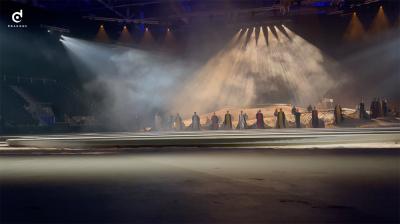
We had a pretty set color palette of various ambers and light blues that I relied on in the show, we stayed in the same color story throughout much of the show. However, when we got to the scene called Neom, or city of the future, we went to a world of vivid magentas, cyans, greens and blues. This is such a contrast from the rest of the show, but so is the idea of this scene. Once the guys at Drop the Spoon added their video elements into this, it really become an iconic moment for me.
My absolutely favorite moment of the show is near the end of the show, Preparation. We treated the entire chandelier with lighting and were very simple with each artist receiving a single light. The vastness of the room immediately vanished, you are left with just the men on stage and the beauty of what they are doing, There is no technology, no grand statement. There is simply the humans and their interactions with the next step, a reminder that less is always more.
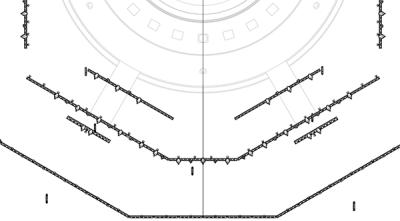
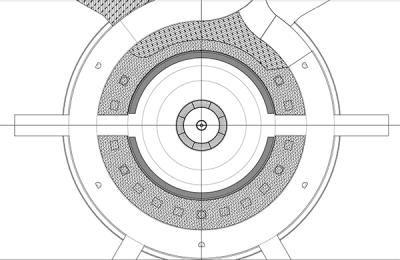
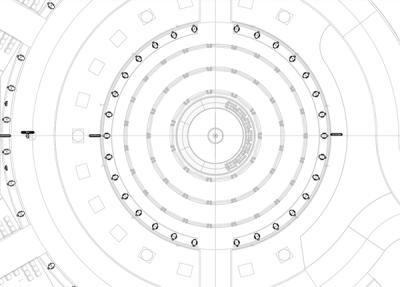
Gear